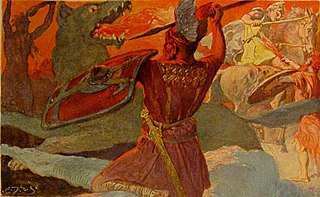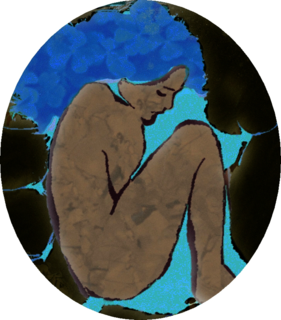In Norse mythology, Sæhrímnir is the creature killed and eaten every night by the Æsir and einherjar. The cook of the gods, Andhrímnir, is responsible for the slaughter of Sæhrímnir and its preparation in the cauldron Eldhrímnir. After Sæhrímnir is eaten, the beast is brought back to life again to provide sustenance for the following day. Sæhrímnir is attested in the Poetic Edda, compiled in the 13th century from earlier traditional material, and the Prose Edda, written in the 13th century by Snorri Sturluson.

In Norse mythology, Vígríðr or Óskópnir is a large field foretold to host a battle between the forces of the gods and the forces of Surtr as part of the events of Ragnarök. The field is attested in the Poetic Edda, compiled in the 13th century from earlier traditional material, and in the Prose Edda, written by Snorri Sturluson in the 13th century. The Poetic Edda briefly mentions the field as where the two forces will battle, whereas the Prose Edda features a fuller account, foretelling that it is the location of the future death of several deities before the world is engulfed in flames and reborn.

In Māori mythology, Rongo or Rongo-mā-Tāne is a major god (atua) of cultivated plants, especially kumara, a vital crop. Other crops cultivated by Māori in traditional times included taro, yams (uwhi), cordyline (tī), and gourds (hue). Because of their tropical origin, most of these crops were difficult to grow except in the far north of the North Island, hence the importance of Rongo in New Zealand.

In Māori mythology, Tangaroa is one of the great gods, the god of the sea. He is a son of Ranginui and Papatūānuku, Sky and Earth. After he joins his brothers Rongo, Tūmatauenga, Haumia, and Tāne in the forcible separation of their parents, he is attacked by his brother Tāwhirimātea, the god of storms, and forced to hide in the sea. Tangaroa is the father of many sea creatures. Tangaroa's son, Punga, has two children, Ikatere, the ancestor of fish, and Tū-te-wehiwehi, the ancestor of reptiles. Terrified by Tāwhirimātea's onslaught, the fish seek shelter in the sea, and the reptiles in the forests. Ever since, Tangaroa has held a grudge with Tāne, the god of forests, because he offers refuge to his runaway children.
In Polynesian languages the word aitu refers to ghosts or spirits, often malevolent. The word is common to many languages of Western and Eastern Polynesia. In the mythology of Tonga, for example, ʻaitu or ʻeitu are lesser gods, many being patrons of specific villages and families. They often take the form of plants or animals, and are often more cruel than other gods. These trouble-making gods are regarded as having come from Samoa. The Tongan word tangi lauʻaitu means to cry from grief, to lament.
In the mythology of Mangaia in the Cook Islands, Amai-te-rangi is a sky demon. One day the people of this world are surprised to see a large basket being lowered from the sky. Some, curious, climb into the basket and are quickly lifted up out of sight, never to return. Amai-te-rangi has taken a liking to human flesh, and has invented the basket and its ropes as a way to satisfy his hunger. He has also heard of the prowess of Ngaru and is determined to catch him.
In a tradition of the Moriori people of the Chatham Islands, Rohe is the wife of the demi-god Māui. Beautiful Rohe was a sister of the sun, and her face shone. A quarrel arose after Rohe remarked that Māui's face was ugly. Māui then decided that they should change faces.
In the mythology of Mangaia in the Cook Islands, the Tapairu are elves or fairies, who are named after the four daughters of Miru, the deformed goddess of the underworld. They were said to have been present when mortals danced in honor of their brother, Tau-Titi. They were also associated with the god Tane.
In the mythology of Mangaia in the Cook Islands, Moko is a wily character and grandfather of the heroic Ngaru.
In a tradition from Mangaia in the Cook Islands, Ngaru (wave) was an ancient hero who lived in Avaiki (Hawaiki).
In the mythology of Mangaia in the Cook Islands, Tikokura is a sea-dwelling evil spirit in the shape of a storm wave.
In Polynesian mythology, Hawaiki is the original home of the Polynesians, before dispersal across Polynesia. It also features as the underworld in many Māori stories.

In Norse mythology, Surtr is a jötunn. Surtr is attested in the Poetic Edda, compiled in the 13th century from earlier traditional sources, and the Prose Edda, written in the 13th century by Snorri Sturluson. In both sources, Surtr is foretold as being a major figure during the events of Ragnarök; carrying his bright sword, he will go to battle against the Æsir, he will do battle with the major god Freyr, and afterward the flames that he brings forth will engulf the Earth.

In Cook Islands mythology, Varima-te-takere also called Vari, was the primordial mother of the gods and mortals.

Gallirallus is a genus that contains about a dozen living, and several recently extinct, species of rails that live in the Australasian-Pacific region. The genus is characterised by an ability to colonise relatively small and isolated islands and thereafter to evolve flightless forms, many of which became extinct following Polynesian settlement.

William Wyatt Gill was an English missionary, active in Australia and the South Pacific region after 1851.

Cook Islands mythology comprises historical myths, legends, and folklore passed down by the ancient Cook Islanders over many generations. Many of the Cook Islands legends were recited through ancient songs and chants. The Cook Islands myths and legends have similarities to general Polynesian mythology, which developed over the centuries into its own unique character.
In Cook Islands mythology, Tumu-te-ana-oa was the female personification of Echo. She was the fourth child of Vari, the primordial mother goddess. Both her name and the land she occupied had to do with the production of echoes. Her name means "the cause (tumu) of the call or voice (oa) heard from caves (ana)". The term oa is used by people when calling out to evoke an echo. Her land was Te Parae-tea, which Gill translates, "The-hollow-gray-rocks". Mamae gives no more detail, but Gill recounts that Tumu-te-ana-oa frequented the caves of Mangaia, where she was seen by Rangi, one of the first inhabitants. The cave in which she was first seen was Aitu-mamaoa.











